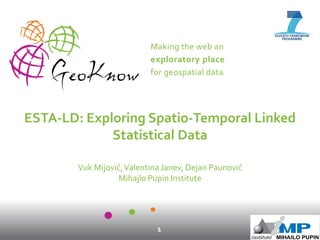
Esta ld -exploring-spatio-temporal-linked-statistical-data
- 1. Making the web an exploratory place for geospatial data 1 ESTA-LD: Exploring Spatio-Temporal Linked Statistical Data Vuk Mijović,Valentina Janev, Dejan Paunović Mihajlo Pupin Institute
- 2. Outline • Introduction • Modelling • ESTA-LD • FutureWork 1 5 S e p t e m b e r 2 0 1 5 2
- 3. Motivation • OGD (Open Government Data) initiatives have helped to open public data on: – transport – education – infrastructure – health – environment – … • Public sector information is usually statistical in nature: – SORS (Statistical Office of the Republic of Serbia – SBRA (Serbian Business Registers Agency) – Eurostat • Public sector information often spans across space and time – Regional development – Tourism data – GDP – … • Statistical data on the web – Create mash-ups – Create visualizations 1 5 S e p t e m b e r 2 0 1 5 3
- 4. Scenario 1 5 S e p t e m b e r 2 0 1 5 4 Agents –Data providers Services LOD convertor LOD convertor Harvesting Sharing metadata with Joinup Metadata catalogue SPARQL endpoint SPARQL endpoint RDBMS RDBMS • Spatio-temporal analysis • Querying and Exploration • Authoring of Linked Data • Semi-automatic link discovery • Enrichment and Repair • Extraction and Loading
- 5. RDF Data CubeVocabulary • Publishing multi-dimensional (statistical) data in a way that it can be linked to related data sets and concepts • Compatible with SDMX • W3C Recommendation • Kinds of data: – Observations – Organizational struct. – Structural metadata – Reference metadata • The cube model: – Dimensions – Attributes – Measures 1 5 S e p t e m b e r 2 0 1 5 5
- 6. Data Cube Example 1 5 S e p t e m b e r 2 0 1 5 6
- 7. Modelling Spatio-Temporal Data • Use SDMX COG (ContentOriented Guidelines) available in RDF: – Temporal dimension: sdmx-dimension:refPeriod – Spatial dimension: sdmx-dimension:refArea • Temporal Dimension – Concept: sdmx-concept:refPeriod – Time role: sdmx:TimeRole – Range: xsd:gYear, xsd:gYearMonth, xsd:date… • Spatial Dimension – Concept: sdmx-concept:refArea – There is no spatial role – Define geometries for concepts using geo:hasDefaultGeometry and geo:asWKT – Hierarhies: • Define a code list • Define hierarchy levels using the SKOS vocabulary (skos:brader and skos:narrower) 1 5 S e p t e m b e r 2 0 1 5 7
- 8. Example: Spatial andTemporal 1 5 S e p t e m b e r 2 0 1 5 8
- 9. ESTA-LD • Enables exploration and analysis of spatio-temporal linked statistical data • Based on the RDF Data Cube vocabulary • Works with any SPARQL Endpoint • Part of the Linked Data Stack developed within EU FP7 project GeoKnow 1 5 S e p t e m b e r 2 0 1 5 9
- 10. Setting Parameters • Choose graph and dataset • Choose measure, set dimension values and select dimensions to visualize 1 5 S e p t e m b e r 2 0 1 5 1 0
- 11. ChartVisualization • Visualization of up to two dimensions • SwitchingAxes • Stacking • Swapping series and categories 1 5 S e p t e m b e r 2 0 1 5 1 1
- 12. Temporal Dimension • Time Chart: – Dedicated chart for the time dimension • Select a period • Slide through time – Works with SBRA/SORS code list and XSD types – Selection of the time window updates the map 1 5 S e p t e m b e r 2 0 1 5 h t t p : / / g e o k n o w. e u 12
- 13. Spatial Dimension • Choropleth Map: – Visualizes data on a map – Supports hierarchies • Regions, municipalities … – Selecting a region updates chart – Regions need to point to polygons supplied asWKT strings – In combination with the time chart, regions are coloured: • Based on the selected time window, • Based on every possible time window of the same duration as the one selected. 1 5 S e p t e m b e r 2 0 1 5 h t t p : / / g e o k n o w. e u 13
- 14. AggregatedColoring 1 5 S e p t e m b e r 2 0 1 5 1 4
- 15. Support for Preparing Data Cubes • Temporal Dimension: – In most cases where time is represented with URIs, those URIs contain year/month/date. – Provides transformation of URIs to xsd types based on the provided pattern • Spatial Dimension: – In most cases country name or code is embedded in the URI – Search for polygons in the LinkedGeoData dataset and add them to the Cube 1 5 S e p t e m b e r 2 0 1 5 h t t p : / / g e o k n o w. e u 15
- 16. Final Remarks • Try ESTA-LD: – GitHub: https://github.com/GeoKnow/ESTA-LD – Demo: http://geoknow.imp.bg.ac.rs/ESTA-LD • Future Work: – Add more chart types – Enable comparisons, merging, slicing, etc. – Reducing the need for replication (DSDs, polygons…) – Advanced search and filtering capabilities 1 5 S e p t e m b e r 2 0 1 5 1 6
- 17. Making the web an exploratory place for geospatial data 17 Thank you for your attention! Questions?
